Click on images or Charmouth Home to return back.
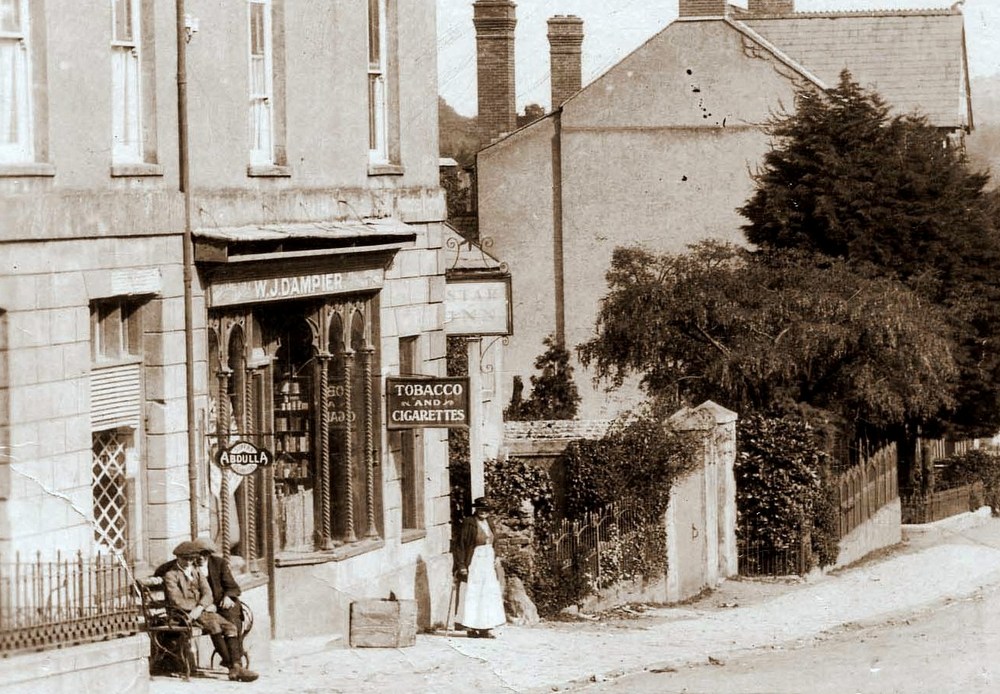
Although part the building housing the present Charmouth Stores is ancient, we are only really interested in the original owner of the shop 200 years ago. This gentleman is Joseph Bradbeer. He originates from Blandford Forum and is shown to marry Elizabeth House there in 1774 and they have at least 3 children - Francis Henry ( 1778) Joseph( 1780) and Maria. The first mention we have of him is in 1790 when his wife Elizabeth sadly dies and is buried in St.Andrews Church, Charmouth. The Parish Records show that was to marry Mary Rogers in the same year.
There are no records of him in the village until 1793 when is is shown as the Landlord of "The Fountain Inn", now Charmouth House at the junction of Higher Sea Lane. Thomas Bidwell is the owner of this historic property which he inherited from his Father- Obadiah. But Joseph is only there briefly before taking over its competitor as landlord in 1796 at "The 3 Crowns", which is now known as the "Coach and Horses", next to the Church on the Street. The Inn is then owned by William Edwards who had recently inherited it from his Grandmother - Hannah Newbury, who ran it for many years. Joseph is shown in the Land Tax records for the village as renting Newlands Farm from Mrs Coade and also Charmouth Meadows from Rev. Brian Coombes. He has also shown as owner of "Balsons" , which may well be the former name of the large thatched building that was sub dived within, next to the Old manor House. In 1801 his son, Francis Henry marries local girl Elizabeth Crout and their property is refereed to as "Crouts" in the Poor rates and also supplied them an income as part was shown to be let by them.


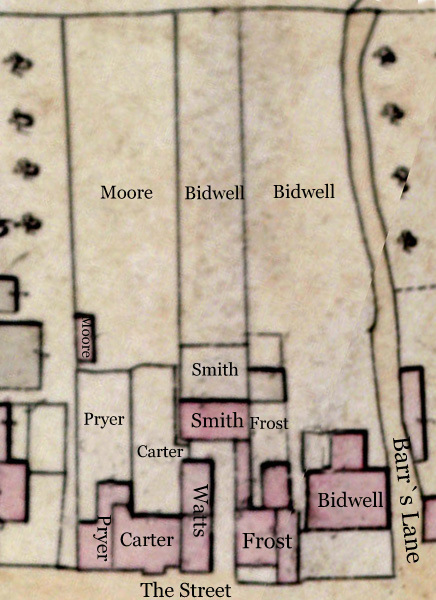

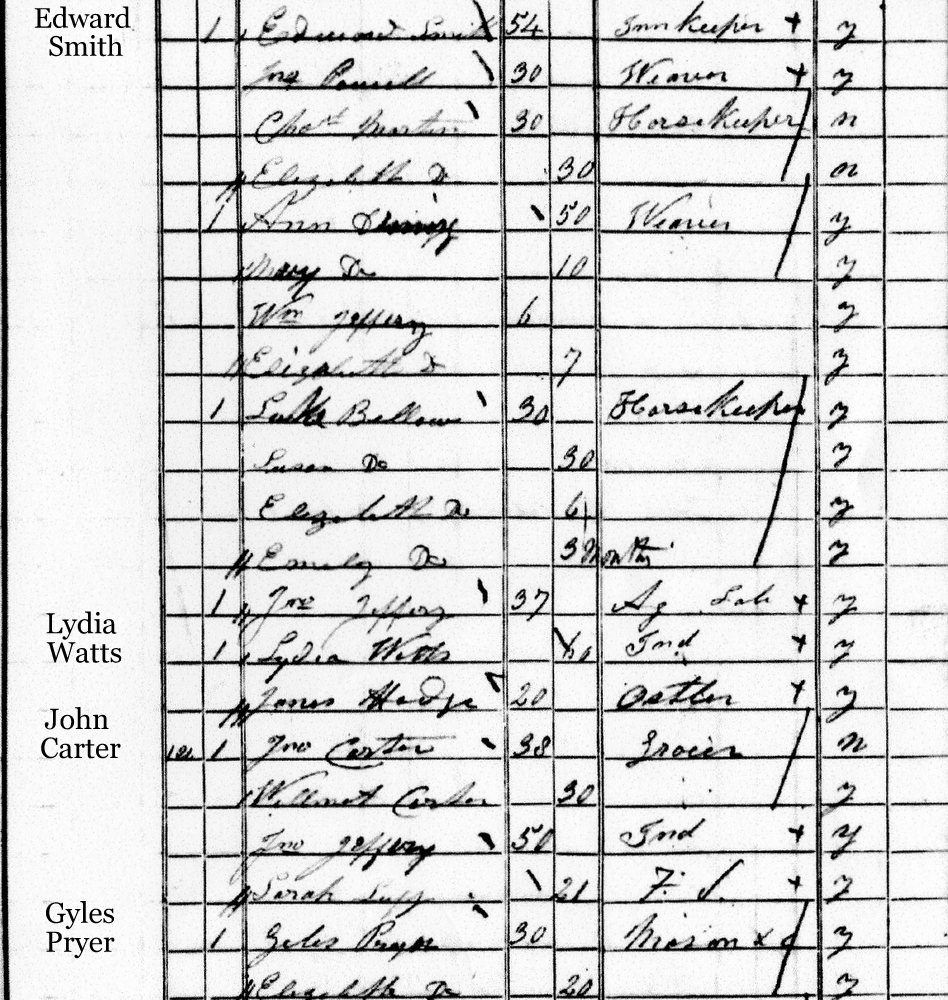
| Tithe no. | Owner | Occupier | Description | Roods | Perches |
| 49 | Painknell BIDWELL | Thomas BIDWELL | House & Garden | 2 | 30 |
| 50 | George BIDDLECOMBE | John FROST | House & Garden |
- | 13 |
| 51 | Edward SMITH | Edward SMITH | House & Court | - | 5 |
| 52 | Benjamin SWAFFIELD | Lydia WATTS & another | Houses | - | 4 |
| 53 | John CARTER | John CARTER | House & Garden | - | 14 |
| 54 | Giles PRIOR | Giles PRIOR | House & Garden | - | 12 |
| 55 | Francis Henry WARING | John MOORE | House & Garden | 1 | 8 |

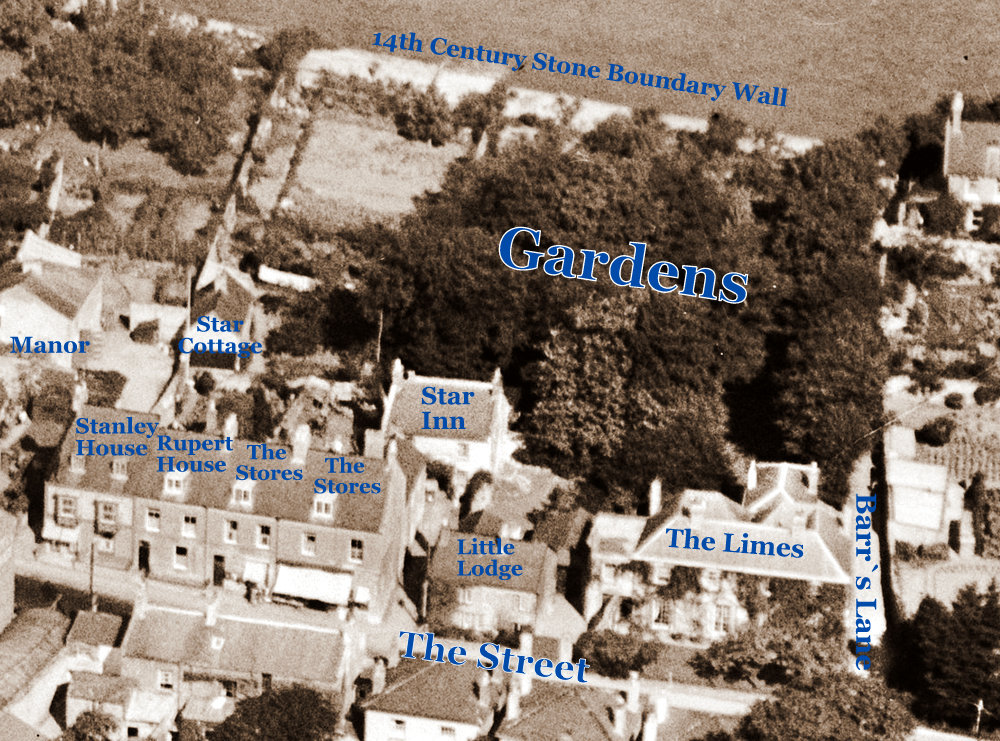 Aerial view taken in 1927 showing The Stores in the centre of the photograph. The area around it was formerly known as "Yandovers" and extended from Barr`s Lane to the Manor boundary.
Aerial view taken in 1927 showing The Stores in the centre of the photograph. The area around it was formerly known as "Yandovers" and extended from Barr`s Lane to the Manor boundary. 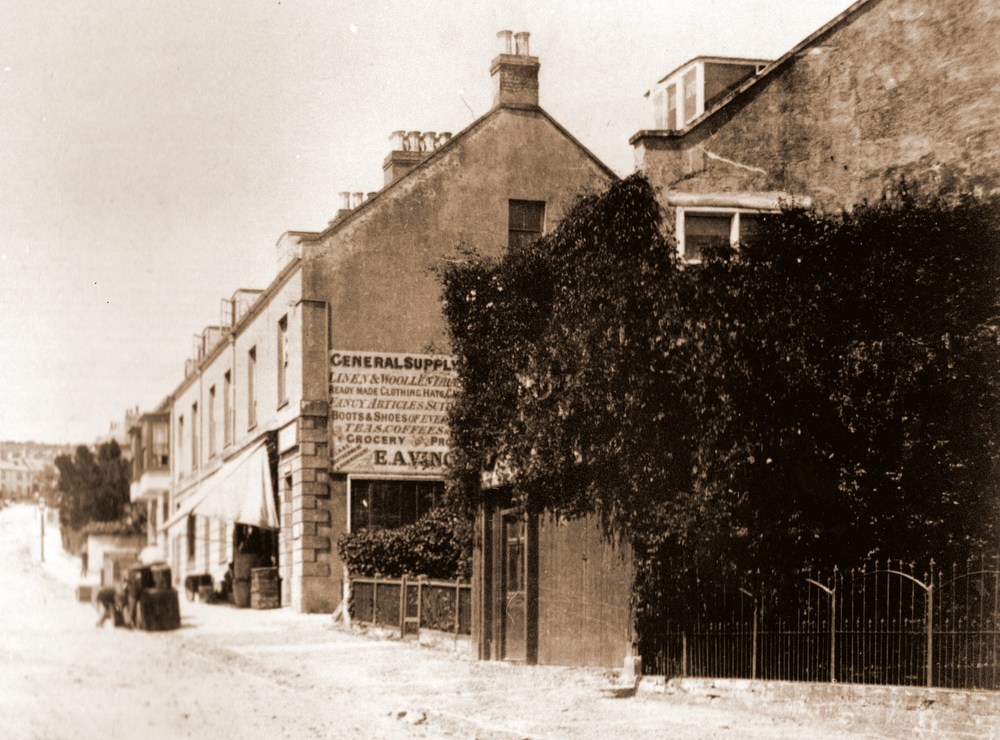


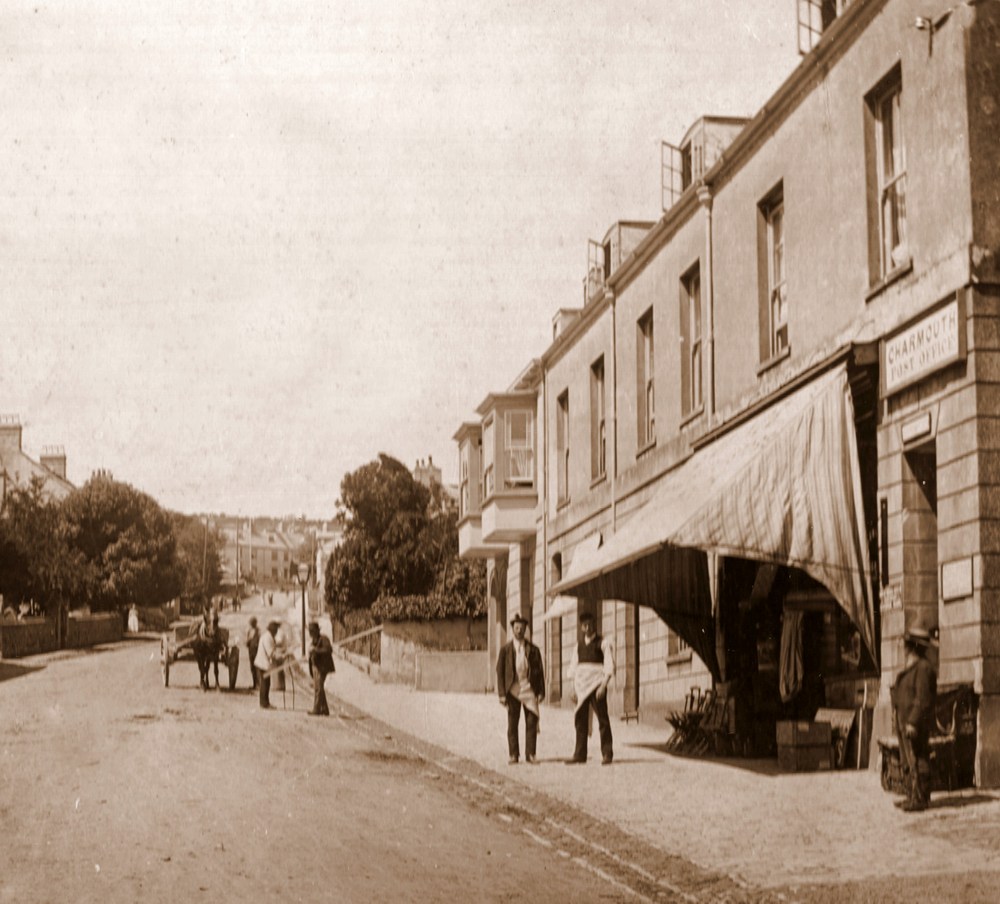

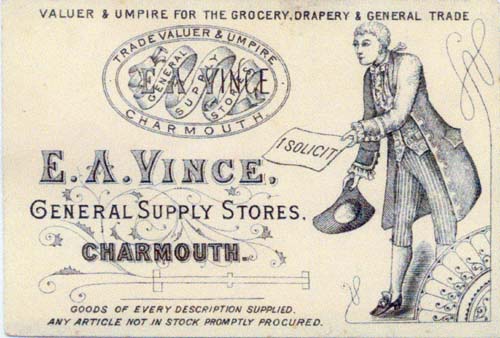




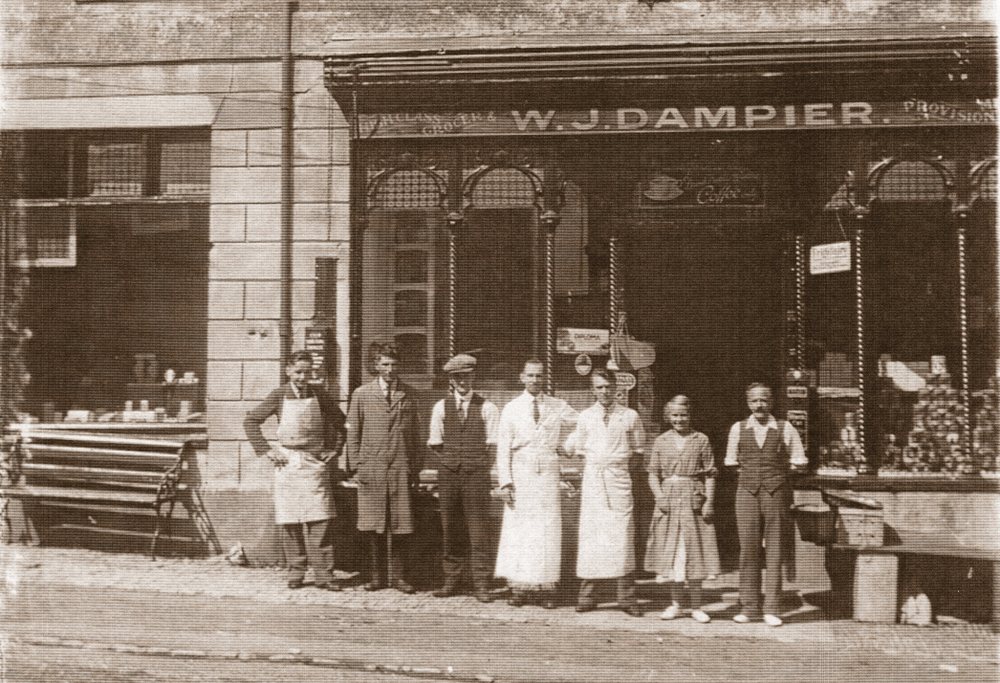

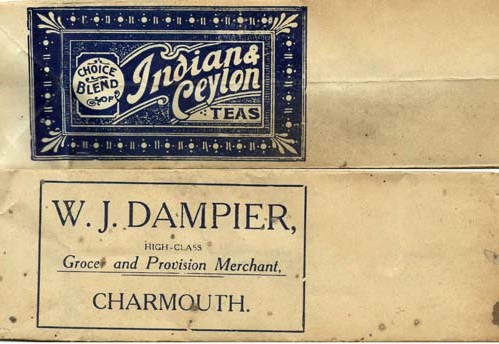



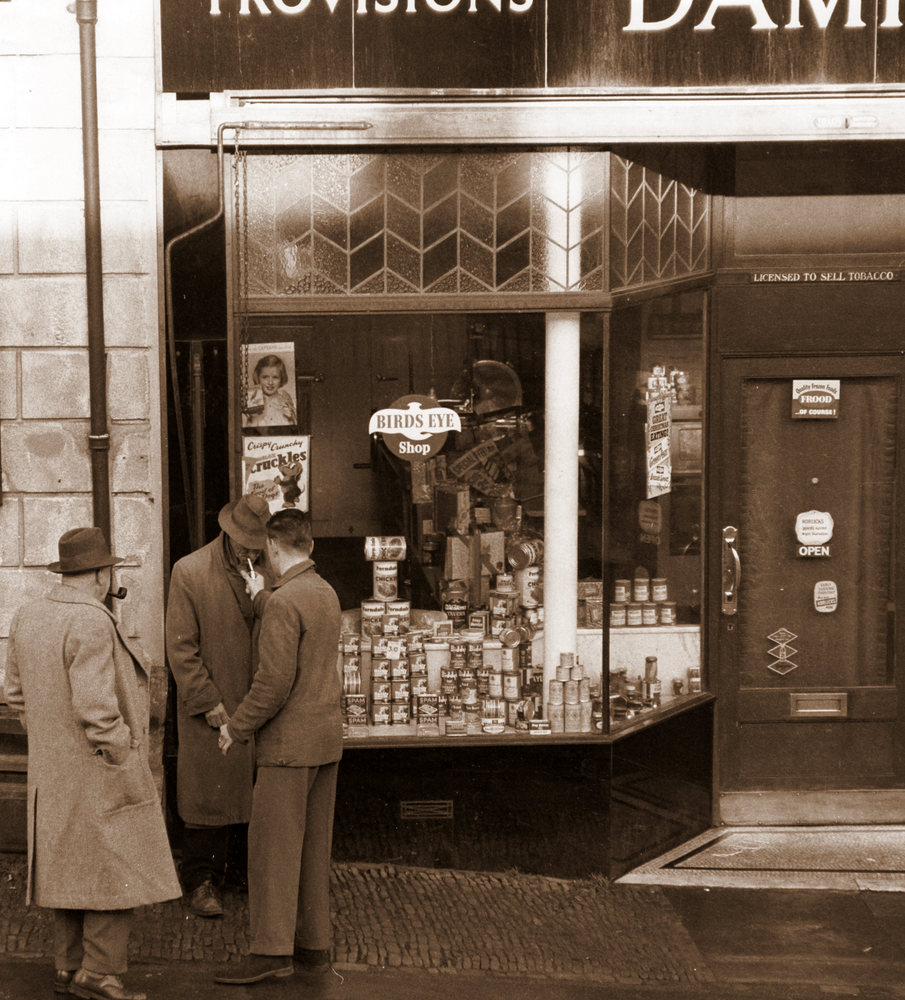
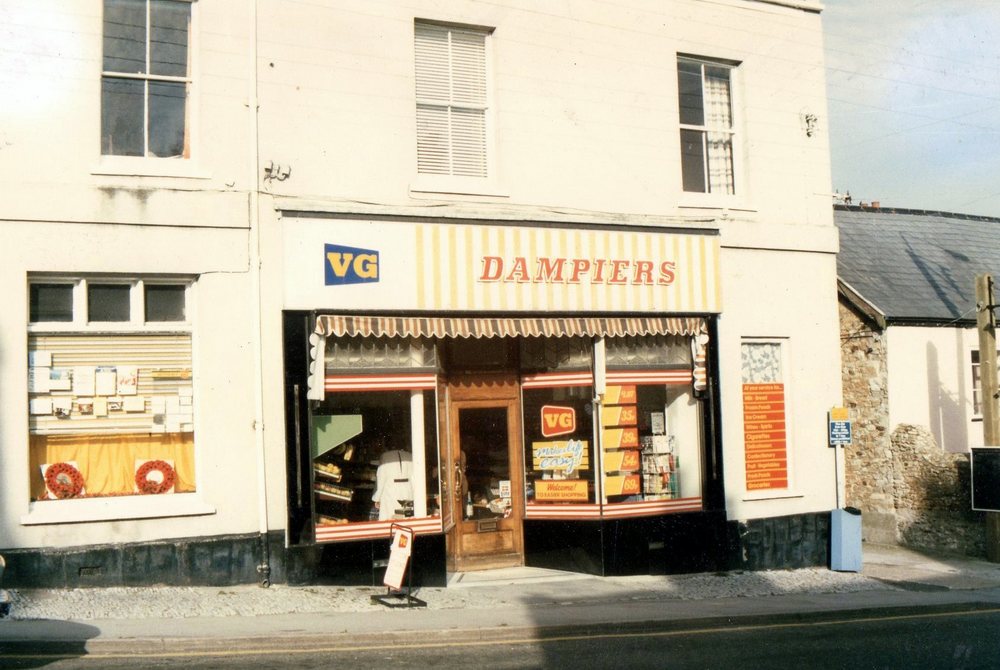
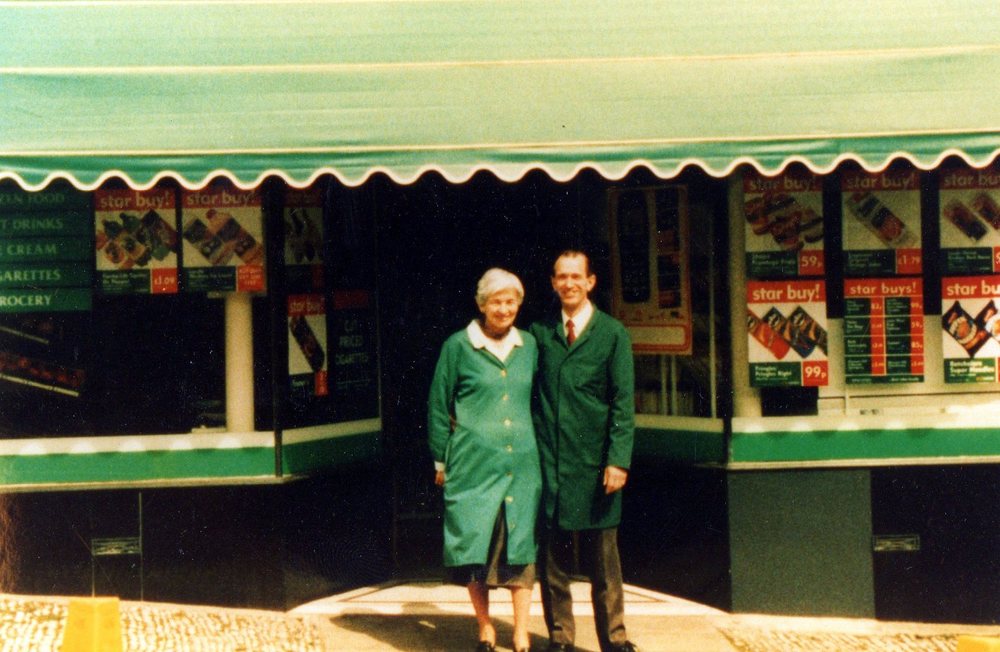
When you enter Charmouth Store (Nisa) today it is difficult to visualise this as one of the oldest continuously run grocers shops in the Country. It dates back to at least 1837 when a Samuel Aplin ran it. He was there only briefly but a letterhead has survived from that time and can be seen in the Dorset Record Office. It reveals what the inside of the premises may have looked like with staff serving from behind the counters. Alongside it a list of all the products and services he could offer. These included Drapery, Grocery Ironmongery, Druggist, Tobacconist, Haberdashery, China, Glass, Pistols and many more items from those far off times. He also shows a hearse and horses outside a church to advertise another service he was able to offer to the departed. He rented the Stores from George Biddlecombe at £26 a year.
The next family to own the shop were the Carters who were to be there for the next 30 years. John Carter who came from Axminster, is described as a Carpenter on the list of Charmouth Citizens who could stand for Jury Service in 1833. He had a workshop on the corner of Lower Sea lane where the Chemist is and a yard, which would have been where the parade of shops are today. By the following year he is shown as a Grocer probably running it from the same premises. He goes on to purchase the shop from Samuel Aplin in 1838 and continues to advertise himself as a builder. He was also the Village Postmaster right at the beginning of the Penny Post in 1840 when the Penny Black was introduced as the first Postage Stamp. The 1841 Census for which he the Village Enumerator describes him as being aged 38, living with his wife Willmet, aged 30. They were to have a son, John, who was born in Charmouth in 1842. Directories of the time advertise the business as that of a Grocers, Post Office and Builders. Sadly John was to die young in 1855 and leaves the shop, three houses in Catherston and a house in Sea Lane (Lower Sea Lane) to his wife who continues running the business with the son, John William (born 1841) later taking it over. The Kelly's Directory of 1859 details the opening hours for the Post Office which stretch from 7.10 in the morning until 10 pm at night.
The 1841 Tithe Map shows the shop forming part of a large thatched building with Lydia Watts in the middle section and the Stone mason,Giles Pryer at the other end. Behind the group was the Star Inn that still survives as a house. In 1864 the Carters business was to dramatically change after a fire broke out in Pryer`s roof. The fire engine came from Lyme Regis and put it out, but it started up again the following morning and spread to the other adjoining buildings which were burnt to the ground. The houses when they were rebuilt were called "Prospect Place". The house on the westward end of Prospect Place is named "Stanley House" and was left by Pryer to his son Henry William on his death. His workshop and yard were on the corner of Sea Lane, where the group of shops are today and had previously been John Carter`s Premises. The following year John William Carter is back in business and advertising in the local directory as Grocer and Postmaster. He continues for awhile, but by 1870 George Mortimer is the owner and an advert a few years later reveals the wide range of goods he can offer. He is shown as a Linen & Woollen Draper, Grocer, Tea Dealer & Provision Merchant, China, Glass, Earthenware & Brush Warehouse and Post Master. The same directory shows Charmouth having six other Grocers as his competition - how times have changed! The 1871 Census for Charmouth has George aged just 28, married to Mary aged 26. He is described as a Postmaster and Shop Keeper. It is interesting to see that has brother, aged 15 and wife's sister aged 19 are living with them as shop assistants. By the 1881 Census he is described as a Merchant employing 9 hands, most of whom seem to be living with them.
He eventually sells the business to Edward Archer Vince in 1888 who continues trading in the same style as is shown in a Directory of 1889. Old Photos of the time show a massive hoarding on the side of the building with a long list of all the goods and services that were offered inside. The door to the Post Office appears to be where the small long window was on the front of the building with a wooden sign above it.
According to Reg Pavey the shop was much smaller than the present day store. A counter was on the left as you entered for the drapery department and the grocery and post office on the opposite side. By the late 1880`s customers were able to telegraph from the premises when a wire was laid to Lyme Regis for it. The 1895 Poor Rates listing show that Edward was renting the premises from Henry Burrough, who in due course was to sell the freehold to Alfred Gapper Pass, who owned a large number of properties in the vicinity, including Wootton Fitzpaine and Monkton Wyld.
John Baker from Steyning in Sussex succeeded Edward in 1896, but by then George Holly was the Post Master running this business from Wistaria on the Street, where it was to remain for the next 40 years. John is shown as being just 30 in the 1891 Census living with his wife Martha and 2-month-old son, John with 3 young shop assistants above the shop. Times were to be hard for him, especially with a severe downtown in trade during the first World War and he eventually put the business up for sale in 1918. It was to be purchased by William John Dampier who had been a Grocery Clerk for the Department Store of Boons and Sons of Dorchester. He was encouraged by his former Employer who helped him with the finance that he needed. For almost the next century the business was to be family run and very well regarded by villagers. William was born in 1878 and with his wife Laura had two sons and three daughters. His son, Donald was to follow him into the business and take over in 1954 and in due course his grandson Ronald joined them and eventually ran it from 1970 until 2000. It is Ron, who still lives in the village that I have to thank for assisting with this article and providing the magnificent photo shown here of William with his staff standing outside the shop with its original Victorian Front in 1935. From the left it is believed that the people shown are Percy Larcombe (young assistant who lived next door), Cecil Bugler (Assistant), Sammy Smith (Delivery Man),Peter Oldworth(Provisions), Donald Hubert Dampier(son), Gladys Frampton(daughter), William John Dampier (Owner). Not long after the shop front was updated to the one that can be seen today. The Dampiers also ran their business from the adjoining premises and the seat that was outside was very poplar and there are usually people to be seen sitting on it on the old postcards. The Dampiers ran a successful business and in due course extended it back and purchased the freehold of the premises from the Pass family. An interesting anecdote regarding the personality of William was revealed in correspondence that Ron still has relating to the famous author, G.K.Chesterton of Father Brown fame. It seems that he and his wife were frequent customers and especially enjoyed the Marmalade that he made and sent to them. One of the verses he was famous for was “The Wicked Grocer”, which reflected badly on the trade, so much so that he felt that he must right the wrong after the impeccable service he had received from the Dampiers at the Charmouth Stores. So as recompense he penned a new verse in 1929 which he dedicated to William called the Good Grocer that is full of his praises. The family still have a signed copy from Chesterton of this verse as a souvenir. Another photograph shown here is of Donald, back in the 1950`s standing behind the original mahogany counter with the shelves behind him piled high with teas and canned fruit. The shop has always kept up with the times and in due course joined various buying groups and the name above the shop changed from APT to VG and then Londis. It is now under the Nisa banner, which allows it to have the same competitive, prices as many supermarkets. The owners, Phil and Carol Tritton continue the traditions of the past by offering a wide range of products and services. The residents of the village are very fortunate to be able to still shop in a building, which started as a Grocers in the year Queen Victoria came to the throne.
